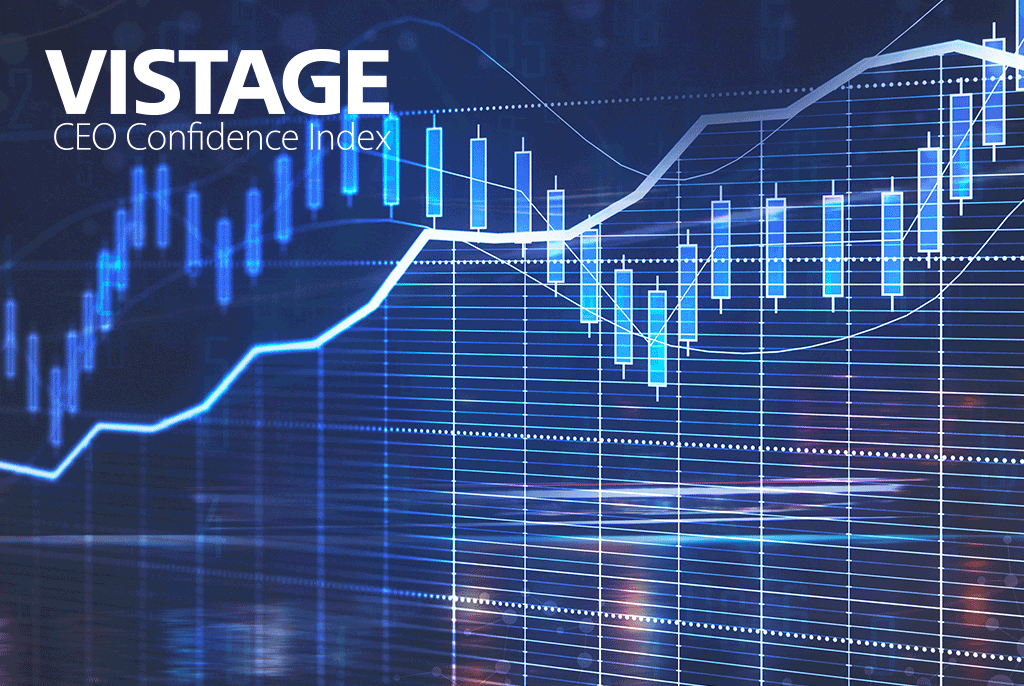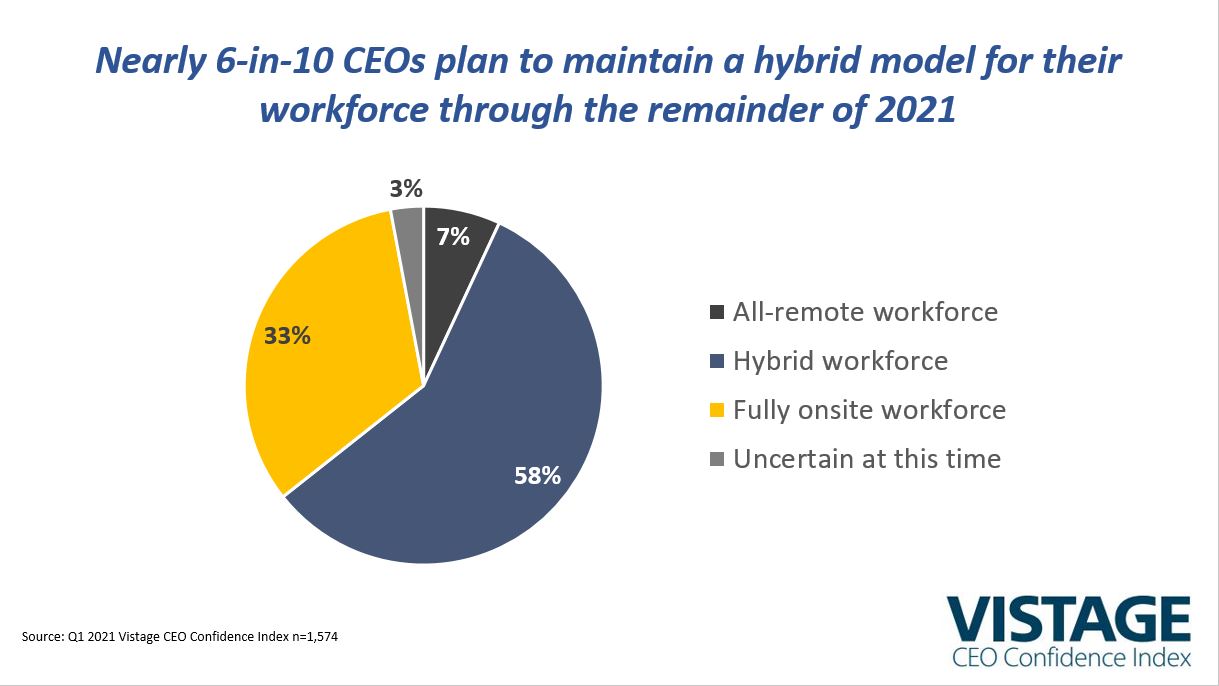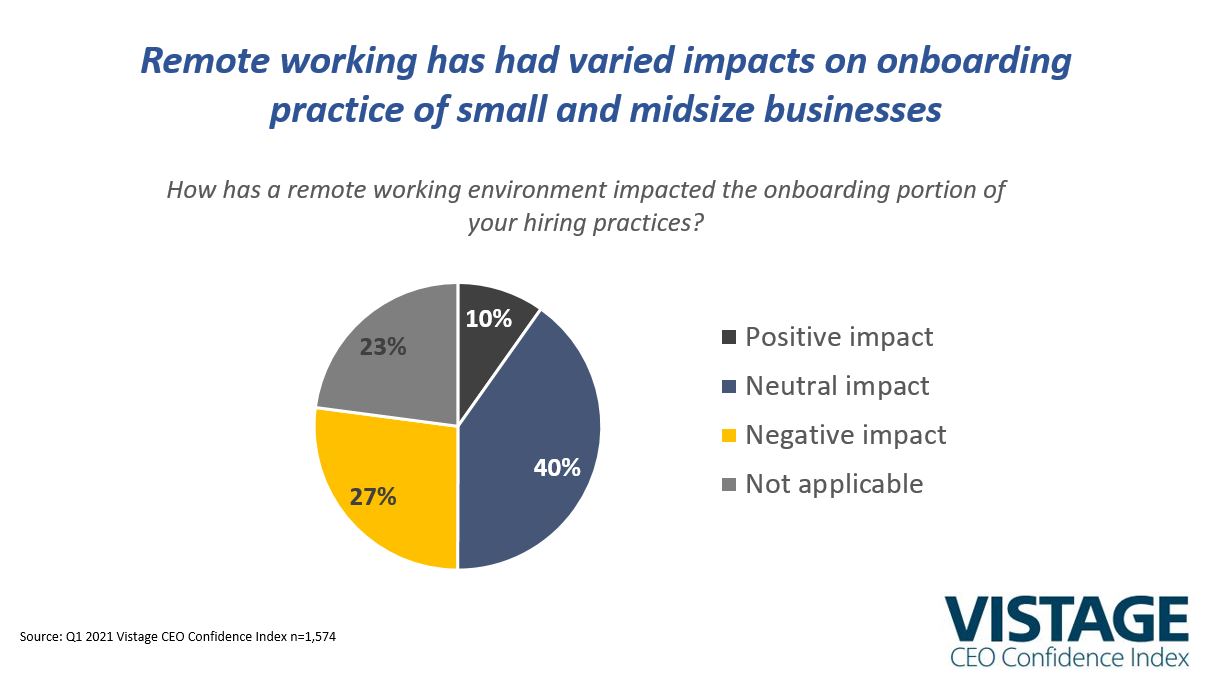Ahead of the surge: CEO optimism jumps [Q1 2021 CEO Confidence Index]

The light at the end of the tunnel is getting brighter for small and midsize businesses. Fueled by radically increasing rates of vaccination, the passage of the $1.9 trillion stimulus package and rising revenues, The Vistage CEO Confidence Index jumped 14 points, reaching 102.4, the highest level since September 2018.
Download the Q1 2021 Vistage CEO Confidence Index report
Optimism increased in each of the six components that comprise the Index, but the primary drivers for the increase were the improving expectations for revenues and profits, which rose 9 points and 6 points respectively in just 90 days. All signals indicate that pent-up demand from consumers and the complete reopening of the economy will spark an economic surge in 2021 and beyond.
Ahead of the surge, CEOs are preparing their businesses to capitalize on the start of the next growth cycle by increasing their fixed investments and headcount. 44% of CEOs plan on increasing their fixed investments in the year ahead on top of the 47% that will maintain current investment levels.
In CEO Projections 2021: Reigniting the Growth Engine we saw that technology was the top investment, followed by hiring. CEOs learned the value of digital transformation and the ever-increasing dependence and importance of technology during the course of the pandemic. Increased headcount is the raw material to power growth.
Flexibility is the new black
Two-thirds of CEOs report plans to increase their headcount in the year ahead. This has ignited the next wave of the talent wars. With 66% of SMBs expanding their workforce and an additional 30% maintaining the size of their workforce, the demand for talent is extreme.
Although unemployment remains at 6.2%, experienced and talented employees in healthy verticals are fully employed. Aggressive recruiting makes employee retention more critical than ever; 70% of CEOs rated retention as very important for their talent management strategy.
Employees have options that become more appealing as the economic and job uncertainty wanes. Losing a key employee can have a devastating effect when businesses are trying to scale to rise to growth potential. Even everyday workers become essential when a replacement will be hard to find, probably cost more and take time to become productive.
Recruiting has replaced hiring. Attracting talent has never been more difficult or important as CEOs hustle to get ahead of the surge; 65% of CEOs reporting that attracting qualified talent was very important to their talent management strategy.
While compensation matters, working for a company with a strong purpose, opportunity for development and advancement, and now work flexibility have risen to the top of employee’s requirements.
The work from home experience has changed the rules for both employers and employees. Given a taste of the work-from-home lifestyle, many existing and potential employees will look at remote working opportunities as a key consideration for staying with or joining a new company. This puts the pending return to work and new hybrid workforce policy decisions front and center for CEOs.
As we transition to the post-COVID workplace, CEOs are debating when to return to work and then in what structure. Based on our survey, just 33% of CEOs plan to be fully on site through 2021. Some of those have no choice given the nature of their work, however for knowledge workers who can be and have been productive from home, this may become an obstacle and a reason to answer the headhunter’s call.
A hybrid model is most common with 58% of CEOs reporting their workforce will offer a balanced schedule between office and remote working for the balance of 2021. Prior to COVID-19, slightly over 2% of CEOs reported they had fully remote workforces. Now 7% will remain fully remote with many planning to stay that way beyond 2021. Just 3% of CEOs are uncertain at this time, but the clock is ticking.
By this time in 2022, the pandemic will be behind us and workplace flexibility policies will need to be in place. The balance between CEOs wanting to return to the Monday-Friday, 9-5 workforce and employees’ desire for flexibility will test employee retention and challenge hiring plans.

Download the Q1 2021 Vistage CEO Confidence Index infographic
The remote workforce has already tested new hire onboarding. The most influential period in any employee’s work experience is their first two weeks. It’s when they are first welcomed “behind the curtain” and have the chance to interact with leaders, managers and co-workers as an employee. Culture is learned through observation and interaction, something difficult to realize with a remote workforce. Employee engagement and the fast path to productivity are all triggered by the onboarding experience. 27% of CEOs reported that onboarding in a remote work environment had a negative effect, potentially leading to slower engagement or rapid turnover of new hires. Only 10% of CEOs said remote working had a positive impact on onboarding, mostly because of the attention paid to the process by fast thinking and progressive HR leaders with dynamic onboarding practices.

A time of transition
The rapid rise in CEO confidence indicates that we have entered a time of transition. No longer unsure about when or if the pandemic will pass, our confidence grows and our anxiety begins to diminish. Left behind is the uncertainty of an unending pandemic, the turmoil of an election cycle unlike any other experienced in our lifetimes and passing of “Peak Covid” in January when hospitalizations and deaths reached unimaginable heights.
Looking ahead we continue to see daily increases in the number of people vaccinated, more businesses and schools reopening and an increasing confidence that the economy will soon ignite sparking the next growth cycle. There will probably be some unforeseen setbacks, but the light at the end of the tunnel keeps getting brighter and with that, CEOs will need to make the right decisions to ensure their businesses can ride the momentum of surge.
Related resources
- Download the Q1 2021 Vistage CEO Confidence Index report
- Download the Q1 2021 Vistage CEO Confidence Index infographic
- About the Vistage CEO Confidence Index

